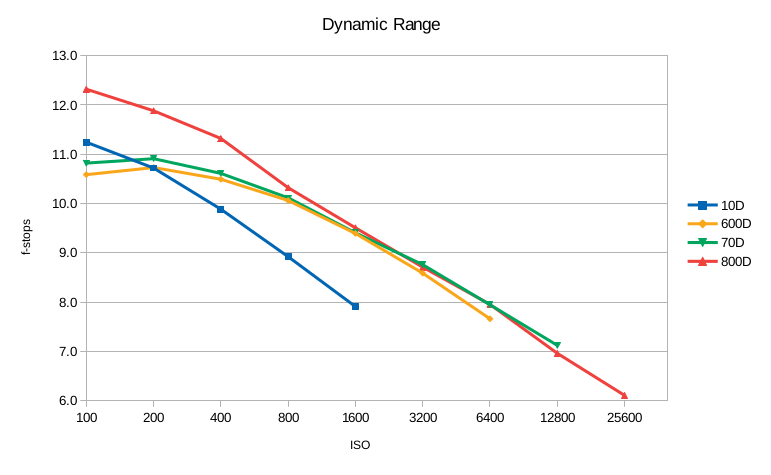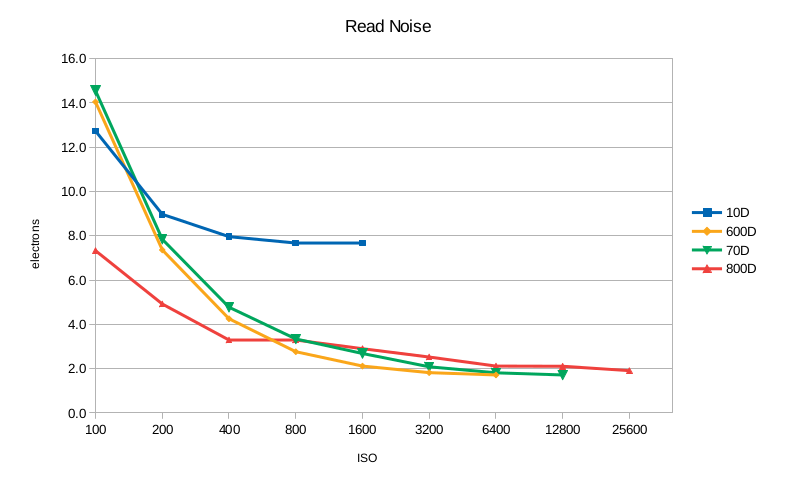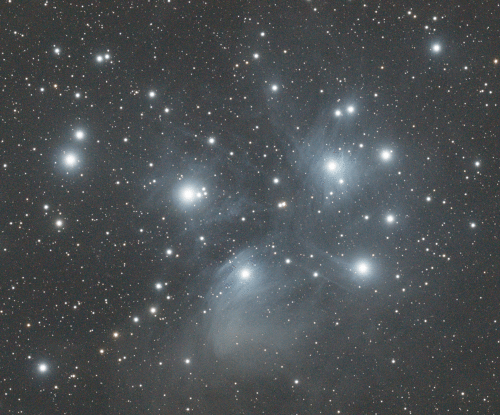Camera update from EOS 600D to EOS 800D (T3i to T7i)
At the time of writing in December 2019 I was using an unmodified Canon EOS 600D (T3i in the US) for my daytime photography and for astro photography as well. It was a purchase that dates back to May 2013 and at that time it was not brand new. Not too long after that so called ISO invariant cameras came up. First Nikons, Canon followed later. I started wondering if it is the right time to update to a more recent model. There are different opinions if Canon or Nikon is better suited for astro photography. Both have pros and cons. From what I watched on YouTube and found in articles Canon came up with the 800D and the 77D at the same time. They are technically quite the same but the 77D comes with the shoulder display. Later the 200D (SL2 in the US) came up with the same sensor as well its successor 250D (SL3). There are differences in auto focus sensors and video features and the 800D is the only one with the 2.5mm plug for remote trigger while all others come with the N3 connector known from old models. As I am used to the buttons positions and menus of my 600D pretty well I decided to go for the 800D which is very similar.I was seriously thinking about getting a Nikon 5300, 5500 or 5600 because they have very good dynamic range values and they are ISO invariant, sometimes also called ISO-less which is technically incorrect. While the performance was outstanding for years now Canon caught up and offers almost the same performance. With quite some technical background from work I decided to measure the sensors of my old 600D and the new 800D. My girlfriend owns the 70D and the ancient 10D from 2003. Why not add them to test?
Sensor testing
For testing I followed the instructions in this book:Digital SLR Astrophotography, Second Edition by Michael A. Covington, ISBN 978-1316639931
Mr. Convington made up loose groups of first, second and third generation cameras. The 10D is a member of the first generation that spoils the image with plenty of noise even at daytime. 600D and 70D belong to the second generation that is much better but obviously suffers from a lot of noise downstream, that is in or near the actual analog digital conversion. These camera are operated at higher ISO settings like 800 or 1600 to flood the downstream noise by plenty of signal. This of course cuts down the dynamic range. The 800D belongs to the third generation of (almost) ISO invariant cameras. At daytime this means if you shoot raw and your image is far too dark you can pull it up in some software and it will be as good as an image with a higher ISO setting. In an ideal world one could use them with the lowest natural ISO setting, probably 100 but as we will soon see, this is not quite the case.
How to measure
The aim of the game is to make up a chart with dynamic range on the y-axis and the ISO setting on the x-axis and a second chart that shows the read noise in electrons for each ISO setting. For a detailed explanation please refer to the book. Basically you need a software that can read out the actual digital numbers in an image and calculate the standard deviation. I used PixInsight. For each ISO setting two bias shots and an image with a saturated part is needed. With that little information the dynamic range and the read noise in digital number (DN) can be calculated. To convert read noise in DN to read noise in electrons the gain factor is calculated from two well exposed but not saturated flats. This is done at one medium ISO setting only because the conversion strictly doubles when going up one full ISO setting or is cut in half when going to a lower setting. I did that at ISO 400. Though not necessary for the bias and the saturated image I used the green pixels only. The test area was a 1000x1000 pixel area in the center of the sensor. Let's have a look at the dynamic range first:
Let's have a look at the read noise:

Before we move on, I would like to thank Michael Covington for his help and feedback on my data.
Real life test
To my great surprise the day the camera came in was followed by a clear night. It was pretty windy but clear, conditions good enough for a test. I decided to go for a shorter focal length and a bright target. So I pointed my 65mm quadruplet to the Seven Sisters or Pleiades. For a true comparison I decided to operate both cameras at he best ISO setting, 400 for the 800D(T7i) and 800 for the 600D(T3i). To compensate the difference in gain and use the higher dynamic range I took 4 minutes subs with the 800D and 2 minutes subs with the 600D. Both cameras supposed to collect the same over all integration time. It would have been nice and easy to image 2 hours with one and 2 hours with the other. As we all know that would not work well because the sky background the the transparency changes over night. So I did it the hard way. First of all I checked if perfect focus with one camera is still perfect focus for the other one. As expected this was the case. So I started with 4 subs of 4 minutes at ISO 400 with the 800D. That sums up to 16 minutes and a bit for dither. Unplugged the trigger cable, carefully removed the camera and replaced it with the 600D. Trigger in, exposure time 2 minutes, 8 subs, which is 16 minutes again. You know how the story goes on. This was repeated 5 times. Alas I needed to do a meridian flip during the session. Replacing a camera sometimes kicked the guide star out of the search field. As you for sure have guessed my focuser is not that rock solid and focus did not remain perfect during the session. The ever stronger wind added to the mediocrity of the images. PixInsights SubframeSelectoScript showed a poor 4 to 6 arcsec FWHM. I sorted out the worst subs and ended up with 19 x 4 minutes and 38 times 2 minutes. For the 600D I have a master bias and a dark library. To save some time and make the procedure even more complicated I took dark frames for the new 800D while her older sister was at work. Now you might say the test is in favor to the 600D because she was allowed to cool down while the 800D was at work all the time. True, but wait...Processing
Thanks to the high speed of 5 images per second taking the 200 bias frames did not take long. Despite my memory upgrade to 16GB the stacking of the bias frames took very long. The darks were stacked as well an the result consists of 17 x 4 minutes. I took 30 flats for each one. Each camera's lights were calibrated using bias, f lats and darks and debayered in PixInsight. There was no cosmetic correction applied. Although one might take a different route I decided to star align all subs to the best one of the 600D, in other words the 24MPix images of the 800D have been scaled down to 18MPix. Of course this reduces noise. On the other hand the larger pixels of the 600D have less shot noise. My idea was to compare the noise at the same resolution. When it comes to presenting the image on screen which is 4k at best or more often only fullHD both images are scaled down anyway. There was neither deconvolution nor denoise done. Both images needed some crop to get rid of the bad borders from dither. As the filter characteristic is very likely different I did a photometric color calibration. For stretching the values suggested by PI's automatic screen stretch were transferred to HistogramTransformation. This results in a strong stretch with a far too bright background. To get rid of an possible intensity differences a linear fit was applied to the 800D's image using the elder sister as a reference. Here is an animated gif, toggling between the two images each second. There is a surprise:

Conclusion
For my level of light pollution and for this bright object the 800D performs better. If the change in the halos is systematic to the sensor or filter package and not a result of dust on the old sensor the 800D will produce better images in any case, even if the background level or the temperature is different. One minor point to complain about is the change of grid lines in life view. They used to be gray in the 600D, now they are black which is perfect for daylight but not at night. Turning the display to a high level and the ISO to maximum generates enough noise to make the lines visible again. If you do not align your mount to the life view but plate solve or use an eye piece, it's not a problem at all. The 800D is a few grams lighter but not really much. If you are on a budget I can still recommend the 600D for the start. I'm not the kind who starts complaining how incredible bad something is because a new slightly better model is out. Both are good cameras for astro photography. As you proceed to dimmer object the 800D is the better option.Thanks for reading!
Remark: The exact same data have been processed again without dark frames. Read more about it here: Are dark frame overrated?
Back to Media
